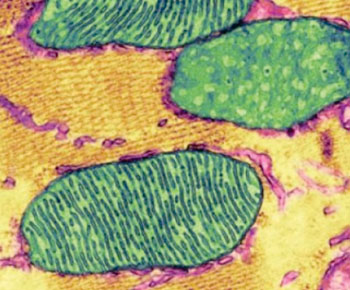Dose of 100-Year-Old Drug for Sleeping Sickness Reverses Autism-Like Symptoms in Lab Mice
By LabMedica International staff writers
Posted on 24 Jun 2014
By exploring a unique hypothesis that suggests autism is a result of faulty cell communication, researchers revealed that a nearly 100-year-old drug approved for treating sleeping sickness has been found to restore normal cellular signaling in a mouse model of autism, reversing symptoms of the neurologic disorder in animals that were the human biologic age equivalent of 30 years old.Posted on 24 Jun 2014
The findings, published in the June 17, 2014, online issue of the journal Translational Psychiatry, follow up on similar research published last year by senior author Robert K. Naviaux, MD, PhD, professor of medicine, pediatrics and pathology, and colleagues at University of California (UC), San Diego School of Medicine (USA).

Image: Transmission electron micrograph of a cell mitochondrion (Photo courtesy of Thomas Deerinck, NCMIR, UC San Diego).
Dr. Naviaux reported that the findings fit well with the theory that autism is caused by an array of interconnected factors, “Twenty percent of the known factors associated with autism are genetic, but most are not. It’s wrong to think of genes and the environment as separate and independent factors. Genes and environmental factors interact. The net result of this interaction is metabolism.”
Dr. Naviaux, who is co-director of the Mitochondrial and Metabolic Disease Center at UC San Diego, said one of the universal symptoms of autism is metabolic disturbances. “Cells have a halo of metabolites and nucleotides surrounding them. These create a sort of chemical glow that broadcasts the state of health of the cell.”
Cells endangered or injured by microbes, such as viruses or bacteria, or by physical forces or by chemicals, such as pollutants, react defensively, a part of the normal immune response, according to Dr. Naviaux. Their membranes harden. Internal metabolic processes are altered, most notably in mitochondria, and communications between cells are dramatically reduced. This is the "cell danger response,” said Dr. Naviaux, and if it persists, the result can be lasting, diverse impairment. If it occurs during childhood, for example, neurodevelopment is delayed.
“Cells behave like countries at war,” said Dr. Naviaux. “When a threat begins, they harden their borders. They don’t trust their neighbors. But without constant communication with the outside, cells begin to function differently. In the case of neurons, it might be by making fewer or too many connections. One way to look at this related to autism is this: When cells stop talking to each other, children stop talking.”
Dr. Naviaux and colleagues have focused on a cellular signaling system linked to both mitochondrial function and to the cell's innate immune function. Specifically, they have zeroed in on the role of nucleotides like adenosine triphosphate (ATP) and other signaling mitokines—molecules generated by distressed mitochondria. These mitokines have separate metabolic functions outside of the cell where they bind to and regulate receptors present on every cell of the body. Nineteen types of so-called purinergic receptors are known to be stimulated by these extracellular nucleotides, and the receptors are known to control a broad range of biological characteristics with relevance to autism, such as impaired language and social skills.
In their latest work, Dr. Naviaux once more evaluated the effect of suramin, a well-known inhibitor of purinergic signaling that was first synthesized in 1916 and is used to treat trypanosomiasis or African sleeping sickness, a parasitic disease. They discovered that suramin inhibited the extracellular signaling pathway used by ATP and other mitokines in a mouse model of autism spectrum disorder (ASD), ending the cell danger response and resulting inflammation. Cells then began to behave normally and autism-like behaviors and metabolism in the mice were corrected.
However, the biologic and behavioral benefits of suramin were not permanent, nor preventive. A single dose remained effective in the mice for approximately five weeks, and then cleared out. Moreover, suramin cannot be taken long-term since it can result in anemia and adrenal gland dysfunction.
Nevertheless, Dr. Naviaux emphasized that these and earlier findings are encouraging enough to soon initiate a small phase 1 clinical trial with children who have ASD. He expects the trial to begin later in 2014.
“Obviously correcting abnormalities in a mouse is a long way from a cure in humans, but we think this approach—antipurinergic therapy—is a new and fresh way to think about and address the challenge of autism. Our work doesn’t contradict what others have discovered or done. It's another perspective. Our idea is that this kind of treatment, eliminating a basic, underlying metabolic dysfunction, removes a hurdle that might make other non-drug behavioral and developmental therapies of autism more effective. The discovery that a single dose of medicine can fundamentally reset metabolism for weeks means that newer and safer drugs might not need to be given chronically. Members of this new class of medicines might need to be given only intermittently during sensitive developmental windows to unblock metabolism and permit improved development in response to many kinds of behavioral and occupational therapies, and to natural play,” he concluded
Related Links:
University of California, San Diego School of Medicine














